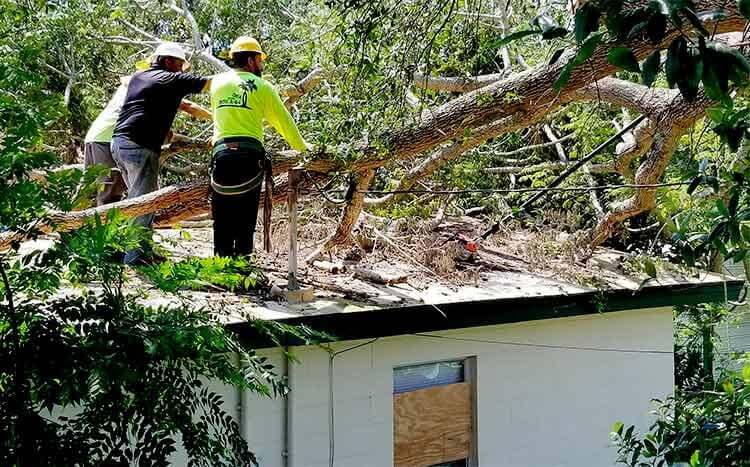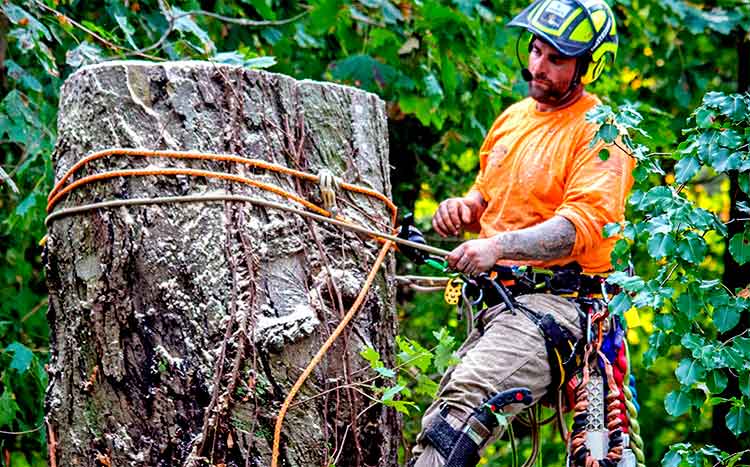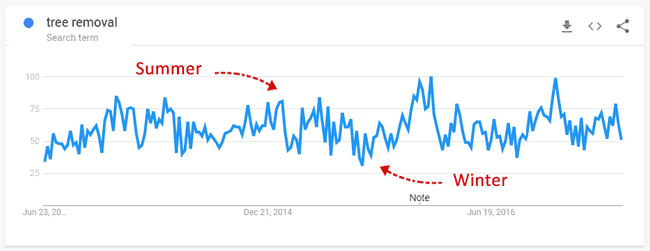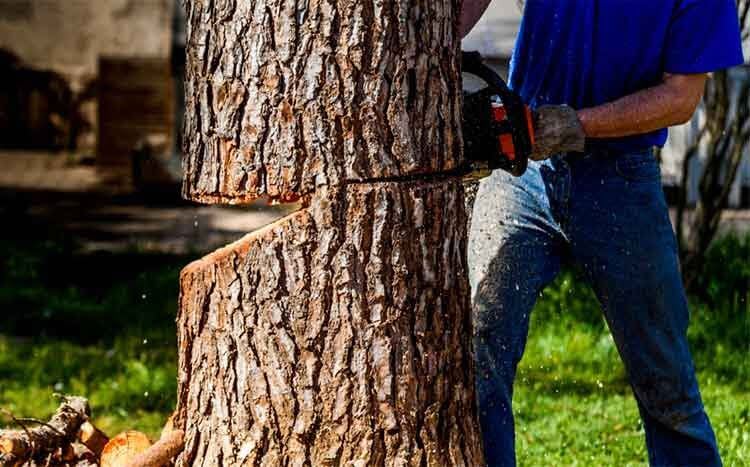Regarding the process of removing trees, it’s a certainty that the expense is significant. Should you have recently obtained estimates from nearby contractors for this service, it’s likely you’ve been taken aback by the exorbitant costs quoted to you.
However, the high costs of tree removal across the country are justified. Arborists charge higher mainly because of the complexity, unpredictability, and risky nature of the tree service. Their overhead costs are also high owing to the high insurance premiums they have to pay.
All these factors then trickle down onto the final value of the quotes you’ll receive.
What we cover
ToggleWhy tree removal is expensive
To get a deeper understanding of how tree service companies price removal, here’s a short breakdown:
Complexity of the job
Tree removal isn’t your everyday job. It requires a lot of preparation, assessment, and skills to complete the job effectively and safely.
The experts have to understand how each branch and limb of the tree will react to a power saw, as well as how the tree holds itself up to ensure that none of the cut parts fall and damage your property or public right of way.
All this makes the entire process tedious and requires specialized machinery like cranes and aerial lifts to work safely. In fact, a typical large tree removal worksite usually has equipment worth more than $150,000.
Therefore, the contractor has to charge you more to be able to manage their ever-increasing overhead costs.

Difficulty and risk involved
Climbing up a storm-damaged tree with a heavy machine like a power saw isn’t the safest of jobs, but tree workers have to do it. Any mistake they make while on the tree can easily cost them their life or injure them permanently.
And if the workers don’t get injured, any miscalculations could mean a tree branch falling and damaging your property and landscape.
When working on trees close to power lines or those with electrical conductors running through their branches, the risk exposure for the tree crew is also pretty high.
High insurance premiums
As you can guess, insuring employees who are constantly in the face of danger is very expensive. Most tree companies have invested millions just for worker compensation insurance and general liability coverage. As such their insurance premiums are quite high compared to other industries.
In some states, tree companies are also required to pay for special licensing besides the standard one. These costs significantly increase the overhead costs of the company which then reflects on their estimates.
Note: Some companies get around the insurance costs by subcontracting the removal to independent contractors in the market, then offer you a lower estimate. Avoid such companies as they leave you (the client) liable for any damages that may happen on the job.
Highly skilled and certified workers
For a job that’s globally regarded as one of the most dangerous, having well-trained and certified workers is compulsory.
Tree companies have to invest in an experienced workforce and also compensate them with wages that reflect their expertise. This means that they’ll have to charge higher labor costs to maintain the quality of their team.
How much does tree removal cost?
The average tree removal cost ranges between $325 – $7,900 with the national average standing at $1,125.
These costs are mainly affected by the size and height of the trees, as well as the tree species. For instance, removing an oak tree costs around $2,300 while the maple tree is about $520.
Here’s how much you can expect to spend depending on the size of the tree.
| Tree | Size | Low | High |
|---|---|---|---|
| Small trees | - 15 ft | $225 | $500 |
| Medium trees | 15 - 25 ft | $500 | $900 |
| Large trees | 25 - 60 ft | $900 | $2,500 |
| Extra-Large trees | 60 - 120 ft | $2,500 | $4,500 |
Factors that affect tree removal costs
Besides the contractors’ hefty overhead costs, there are several other factors that add to the already expensive removal costs. These include:
The condition of the tree
Trees in strong and healthy condition will cost you more in removal costs, compared to a weak and dying tree. Moreover, removing trees after storm damage will be charged higher due to the dangers associated with it.
Location (Accessibility)
The location of the tree on your property determines how accessible it is for the tree crew. Accessibility is important because it affects how much manual labor will be required and subsequently how much you incur in labor costs.
Poorly located trees may also require the experts to utilize complex techniques and state-of-the-art equipment. For this, they’re bound to increase their prices.
Generally, removing a tree in an open area like the front yard might be nearly 50% cheaper than one in your backyard. Additionally, removing tree branches close to power lines will also increase costs due to the added risk.
Diameter of the trunk
The bigger the tree’s diameter the more costly it is to remove. This is because big trunks increase the amount of work required. The costs will also increase by nearly 15% if you also need to grind the stump.
Tree companies charge higher to grind shorter but large stumps, than smaller and taller stumps.
Demand and emergencies
During the peak seasons, most companies will charge you higher since the demand for their service is higher. The same applies if you need emergency tree removal like storm damage or a tree fell on a power line or your home.
Additional services
Most contractors also charge you a premium rate to complete other extra services like tree debris removal and removing obstacles around the tree like outdoor furniture and telephone lines. If you intend to do these tasks, make it clear during the quote process.
5 Tips to save money on tree removal
Just because tree removal is expensive doesn’t mean you can’t get amazing deals that’ll save you a load of cash. Here are some of the most effective tips from Ben “The Tree Man” that have saved our readers nearly half the price!

1. Take advantage of winter!
The tree industry is highly seasonal. This means that there are months when contractors are completely booked, and others when they are almost out of work. Just look at this trend from Google for the search “tree removal services near me.”

Understanding these periods can drastically change how much you spend on tree removal!
The best time to hire a tree company is during winter, when business is slow for most companies while in summer, there’s a spike in demand for the services. Therefore, a contractor is more likely to give you their best deal for your removal job during winter because they desperately need the job to keep running.
There are also some quiet companies you can look for during summer if you have an emergency. However, you’ll have to know the right places to look.
2. Remove obstacles to improve access
As earlier mentioned, poor accessibility to your tree increases a contractor’s labor costs, and this is reflected in their final quote. So, to cut down your costs, remove anything that limits a contractor from bringing his/her machinery close to the tree.
Depending on the tree’s location, you can remove a panel of your fence to enable the contractor to get his equipment as close as possible to the tree.
If you don’t have a driveway and the tree is in the backyard, talk to your neighbor to allow the contractor to access your tree through their yard.
This trick alone can save you thousands of dollars.
3. Clear the space around the tree
Besides accessibility and location, contractors will also require enough space around the tree to make bringing the branches to the ground easier.
If your home has very little space, the contractors will charge you higher since their labor will increase. Little room for movement also means more time, manpower and techniques will be needed to get the branches to the back of a truck.
By assuring the contractor you’ll remove everything that’s around the base of that tree, you’ll make it easier for him/her to fell the tree. This will reduce their labor costs and hence your overall quote will be lower.
4. Offer to dispose of green waste / Cleanup yourself
Once the tree is down, you don’t have to spend an extra coin on the contractor to dispose of the timber. You have the option to hire a skip, sell the timber as firewood on eBay or Gumtree, dispose of it in your green waste bin, or even put it out for the council waste collection day. Either way, you’ll save a couple of hundred dollars by cleaning up tree debris yourself.
5. Hire a gardener instead
Not every tree removal job must be done by a qualified arborist. For the short and small trees, i.e., less than 5m high with trunks smaller than 15 cm in diameter, your gardener can handle the job just fine.
What’s more, they’ll do it for a significantly more affordable price since they don’t require expensive equipment or an insurance policy.
Want to find an affordable company?
Try our FREE service at GoTreeQuotes! In just under two minutes, we will match you with three local tree arborists, all of whom have been voted the best and most affordable by previous users in your area.
- Scroll up to the top of the page and enter your Zip code.
- Fill out the quick 23-second form with details about your tree removal job.
- Your tree details are forwarded to the closest three tree services who will bid on your job at a great price.

Why do estimates vary so drastically between contractors?
Well, every contractor is different in the way they evaluate projects. This means that you can’t expect to have them arrive at the same figure.
Nevertheless, there might be more than meets the eye for quotes that are too far apart.
The possible reasons include the following:
- Contractors on a slow month – Desperate contractors tend to be more aggressive with their pricing when looking to win a job. They’ll therefore quote a relatively low price compared to the standard in the market.
- Contractors on a busy month – Contractors who’re already booked for some time will price their projects quite high as a polite way of saying they can’t handle your job. However, if you can match the price, they could find a way to work on it.
- Wages for their workers – Ideally, how much a contractor pays his/her tree crew will significantly impact their overall quote. For example, contractors paying minimum wage to their workers will quote lower estimates than those paying their workers higher.
- The difference in assessment – Since there’s no standard way of assessing a tree project, some contractors may be more thorough in their inspection and thus include most of the costs incurred during the project. Other contractors aren’t very detailed and leave room for many hidden fees once the project is underway.
Note: A contractor’s pricing can tell you a lot about their experience and the quality they can deliver. Therefore, don’t automatically go for the cheapest contractor, but seek to find the reasons behind their pricing.
FAQ's
Most arborists require very expensive equipment and pay premium insurance rates for their workers. This means that their overhead costs are quite high and they’ll need to charge higher to offset their operation costs.
Yes! If left alone, stumps start decaying and become home to many insects like termites and carpenter ants. Removing it is the best way to avoid these insect infestations.
Yes! However, you’ll need a permit from your local council before proceeding with the job. If the tree is very large, you’ll need the help of a qualified arborist.
Yes! If you find a contractor’s quote to be too high, it’s possible to negotiate a better deal that’s within your budget. This may mean doing most of the clean-up and waste disposal yourself.















